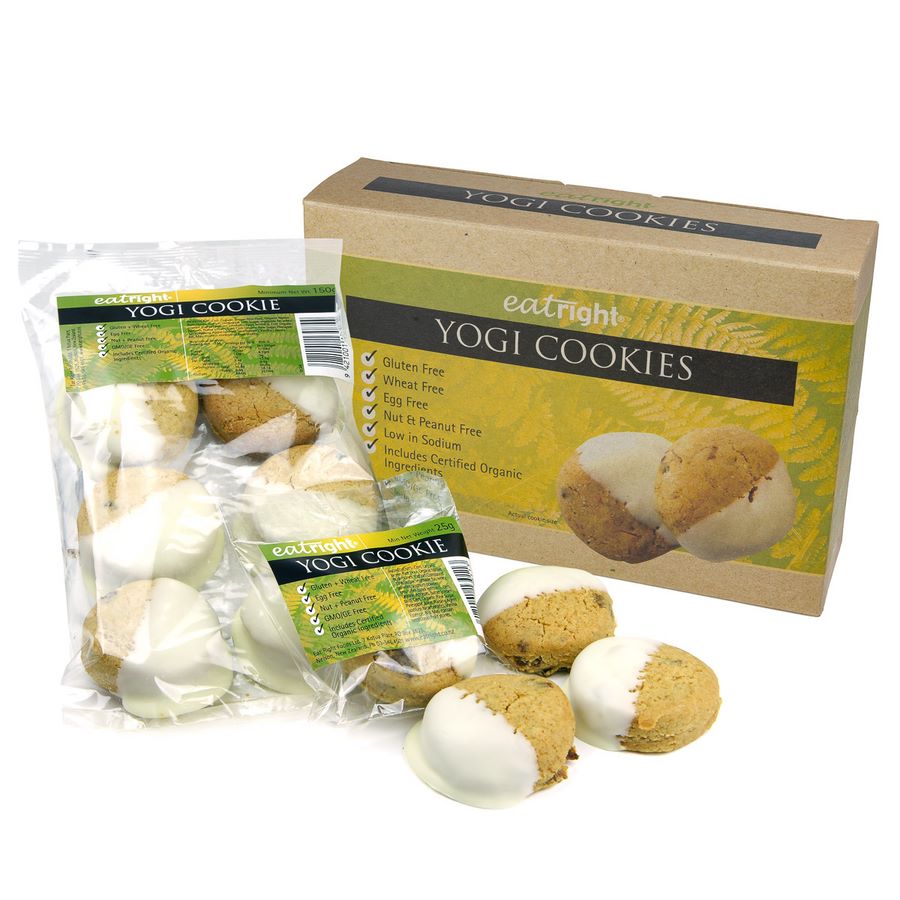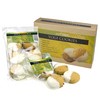Yogi [†] (Yogurt & Apricot) Cookies
This one takes a lot of beating. It 'speaks for itself!'. Great for sharing. NOT over processed, not [twin screw] extruded or mass produced [††]. It contains naturally gluten free (not reconstituted) cert organic stone ground grist, is vegetarian friendly, a source of lipid&water soluble vitamins and non GMO, GE free.
Visually distinctive [1], it is half dipped in yogurt with four LIVE culture strains (hence the "YOG" part of the "yogi" abbreviation, [heat 'hurt' removed (<50degC), so now yog-urt]) and a great tasting combination of apr I cots (the "i" part of the "yogi" abbreviation), pineapple juice and native New Zealand bush honey. (Honey has been listed as a potentially endangered food along with crops such as Nelson grown Oratia Beauty apples) [2].
Apricot Cookie Ingredients: Cert. organic stoneground ‘whole’ not “reconstituted whole” flours (unhulled brank (Fagopyrum esculentum Moench), brown rice [^]), bush honey (native kanuka, honeydew), cert. organic sundried apricots (10%) [provides 100% RDI vitamin A, source of iron, potassium. no 'maybe dangerous to asthmatics' sulphites eg E221 (preservative, photograph 'fixing'], cert organic unsalted butter (milk), cert. organic [non-centrifugal (NCS)] raw sugar, pineapple juice [3].
Yogurt Enrobing Ingredients: non-tempered (cert. organic raw sugar, cert. organic cold pressed cacao butter (from sun-dried, heirloom cacao beans), milk solids, soy lecithin, live yogurt cultures (L.bulgaricus, S.thermophilus, L.acidophilus, L.rhamnosus) [min. 80 billion cfu^/100g; “Yoghurt cultures (live)” assists with “lactose digestion” EFSA Article 13 health claim: ID 2976])
Contains: milk, soy. ^cfu = colony forming units from Live Yogurt Cultures
Nutrition Information: 10 servings per container. Serving size: 1 cookie (25g/0.9oz)
Amount per serving. Calories 120 Cal. Total Fat 5.0g (8%DV), Saturated Fat 4.0g (20%DV), Trans Fat 0.3g (1.5%DV). Cholesterol 15mg (5%DV). Sodium 29mg (1%DV). Total Carbohydrate 17g (6%DV). Dietary Fiber 5.0g (18%DV), Total Sugars 7.0g, Includes 4g Added Sugars 8%. Protein 1.0g. Vitamin D 2.0mcg (10%DV). Calcium 3.8mg (0.3%DV). Iron 1.4mg (1%DV). Potassium 86mg (2%DV).
The % Daily Value (%DV) tells you how much a nutrient, in a serving of food, contributes to a daily diet. 2,000 calories a day is used for general nutrition advice.
Shelf life: 18 weeks or more. Can be chilled or frozen indefinitely (at 0ºC (32ºF) or less)
Detail: Food Safety Verification Certificate Number 2699 (IANZ inspection body audit, pursuant to the Food Act 2014) issued to Eat Right Food Ltd for the manufacture, processing, exporting, packing, holding and distribution of food products
Address: PO Box 1525 [Level 1, 6 Church St], Nelson 7040, Tasman [Blind] Bay, NEW ZEALAND
Packaging: Various package options are available...
* [customized sizes and micron] cellophane bags with or without a gusset
* ["ERF"] intricate system [incl. ‘loaded for “global” distribution’] bespoke 'fiber packaging' [†††] {*} food carton printed using vegetable oil pigments]. NB. The EATRIGHT® fibre packaging is the only type where all the labeling requirements are NOT in one easy-to-find front of pack space.
* [off the shelf] kraft pouches and others
Other: Originally ‘set up with an (incorporated) virtual slot in the warehouse’
NB: 'YOGI COOKIE' priority of use date: 1st August 2001 [c/- USPTO applications nos. 77511916 and 711511918]
“According to Ayurveda [Indian Traditional Medicine: ‘‘ayus’’ meaning ‘‘life” and ‘‘veda’’ meaning ‘‘knowledge”], all objects in the universe including the human body are composed of five basic elements...earth, water, fire, air, and vacuum (ether)...It is believed that illness and disease result from an imbalance in the five elements…defines 32 causes of disease resulting in imbalance. Among them are pathogens such as parasites [eg Krimi, worm infestation]…The most important category is prajnaparadha or intellectual insufficiency” Leung’s encyclopedia of common natural ingredients used in food, drugs & cosmetics by Ikhlas A. Khan & Ehab A. Abourashed (3rd ed pub '10).
The metals used in the Ayurvedic system of medicine include gold, silver [L argentum], copper, mercury, tin, lead, iron and zinc [nb. caveats on dosage and preparation purity]. But what about naturally occurring sources, of these particular trace elements, in our food? We have already researched EATRIGHT® food products for iron, zinc and even copper with recommended daily allowances [c/- minimum lower limits, upper tolerable intake levels and PTD (probable toxic dosages)]. But other minerals, present in parts-per-million (ppm) dosages, and their use to combat worm infestations and other diseases (rather than added “edible gold” [food additive E 175] [4], “edible silver” [E 174], gold salt compounds, colloidal suspensions, nanoparticle isolates etc) are important.
ChemID: COPPER. Ubiquitous: YES. Ananas comosus (pineapple, fruit) 1ppm low; 8.8ppm high; StdDev 0.31279 Ref: USDA's Ag Handbook 8 and sequelae
Please refer to other EATRIGHT® products for more information on their "natural source" of essential, and potential, mineral contents
Inconvenient FOOTNOTE: 2:13-cv-02174 request for PRODUCTION 44 “no way of generating a report from the Lean Meats [Hastings 4120, New Zealand] Database unless you are able to give me the Vessel and Voyage details” (13Feb15). Where opinion by Justice [JOHN Simpson] HASTINGS in Ekco Products Co. v. FTC, 347 F.2d 745 (7th Cir. 1965) "conglomerate in nature...Ekco is a leading producer of commercial food and meat-handling equipment and containers, including kitchen tools, tinware, cutlery, stainless steel cooking utensils, flatware and other similar items. It is the largest manufacturer of baking pans for commercial and industrial uses" (see also relevant USPTO Design Search Code category 11)
Product Details
- Apricot. Source of non-ubiquitous ['the POWER of Lycopene, a potent antioxidant…better absorbed when fats are present']. List, P.H. and Horhammer, L., Hager's Handbuch der Pharmazeutischen Praxis, Vols. 2-6, Springer-Verlag, Berlin, 1969-1979
- Apricot (Prunus armeniaca L.) [ancient superfruit] from Turkey. Synonyms - Armeniaca vulgaris, P. armeniaca var. vulgaris. Vitamin-A-Activity. Apricot. Alpha- cryptoxanthin. Dr Duke's Phytochemical, Ethnobotanical Databases (USDA, '16)
- Apricot. phytochemID. ESTROGENS. Ubiquitous. NO. 900ppm. Activity: HDL-genic (high-density lipoprotein) Ref: Newall, C. A., Anderson, L. A. and Phillipson, J. D. 1996. Herbal Medicine - A Guide for Health-care Professionals. The Pharmaceutical Press, London. 296pp.
- Apricot. Ethnobotany Use: Preventative. Biological Activities: Previtamin-A (gamma-carotene source) and Vitamin-A-Activity (alpha- cryptoxanthin source). Dr Duke's Phytochemical and Ethnobotanical Databases (pub. 2016)
- Pineapple (Ananas comosus (L.) Merr.) Drug: [plant protease] Bromelain. Action/clinical use: Antiinflammatory, Proteolytic agent. [†] Tropical Plants Yielding Clinically Useful Drugs Farnsworth, N. R. & D. D. Soejarto. 1988. Global importance of medicinal plants (unpublished draft manuscript r
- Pineapple. plant source of ethyl and methyl-butyrate. Ethnobotany Use. ESTROGENIC. Ref: Wong, W. 1976. Some folk medicinal plants from Trinidad. Economic Botany 30(2): 103-142.
- Butter is the richest source of dietary butyrate (3–4% butyric acid, in the form of tributyrin (butyryl triglyceride)). One molecule of tributyrin is metabolized into three short-chain fatty acid (SCFA) butyrate molecules by bacterial fermentation of fiber [**]
- Ingested buckwheat: ethnobotany uses: [without luo (Latin, wash)] retinitis (eye inflammation), CVI (chronic venous insufficiency) et al ref: DAD abbreviation for Duke and duCellier (1993)
- PhytochemID: Malic-acid. Ubiquitous NO. Apricot (7000ppm-22000ppm), Pineapple (1000ppm-4700ppm). Total activities 15: antiatherosclerotic, antibacterial, antifibromyalgic (300mg 3x/day) et al. Dr Duke's Phytochemical and Ethnobotanical Databases (USDA, 2016)
- Biological activity: demulcent [relieving inflammation and irritation]. Sources: pineapple, apricot, cacoa Dr Duke's Phytochemical and Ethnobotanical Databases (pub. 2016)
- Milk solids. See milk, cow, powder, instant, whole (F37) water content 6.2g/240g or 2.6%. (NZ Food Comp. Database). Not 'milk-&-water (verb) ...feeble'
- [^] Non-beet or wheat source of non-ubiquitous guanine Phytochemical Dictionary by Jeffery Harborne and H. Baxter (pub. 1983)
- [†] yo’gi (-gi), n. Devotee of Yoga [art of transformation]. Amazon (a-), n. Female warrior, esp. of fabulous race in Scythia; masculine woman. Amazon'ian a. [Gk]. Pocket Oxford Dictionary (4th ed.'42, revised, reprinted with corrections '52) See also Iliad and USPTO 75700168.
- [††] Interfood Read Group Ltd; “solutions for smarter food processing”; www.reads.co.nz. With Eat Right Foods re:purposing equipment designed for one industry to another
- [†††] “Primitive as it may look…an intricate system” Reinventing the Bazaar a Natural History of Markets by John McMillan (pub. 2002). Endex (New Zealand Food Technology) Industry News (pub. Sep’07) http://www.endex.co.nz/article.php?id=745
- [1] Food digestion: a full sensory experience
see eg 'more than the sum of its (nutrient) parts'
- [2] WHAT IS HAPPENING TO AGROBIODIVERSITY?
Source: FAO. 1999b
- [3] ID 2212&3: “Ananas comosus - common name: Bromelain, Pineapple” and “Digestion, Vascular and Vein Health”
European Food Safety Authority Unit on Dietetic Products, Nutrition and Allergies Consolidated list of Article 13 health claims List of references received by EFSA Part 3 IDs 2001-3000 (pub. Apr’11)
- [4] Scientific Opinion on the re-evaluation of gold (E 175) as a food additive”
by EFSA Panel on Food Additives and Nutrient Sources added to Food (ANS) (pub. Jan’16)
- {*} “Pride and Print Awards Highly Commended (2008)” also offline “Awards Annual” p41 “Gold/Highly Commended Winners”
p2 “2008 Winners List” Category: “Packaging - Folding Cartons - 4 or More Colours”; Entered by: “Pakworld”; Title of Entry: “Eatright Cookie Carton”; Medal Won “H/C”
- [**] Butyrate, Neuroepigenetics and the Gut Microbiome: Can a High Fiber Diet Improve Brain Health?
by Bourassa MW, Alim I, Bultman SJ, Ratan RR


![Yogi [†] (Yogurt & Apricot) Cookies Yogi [†] (Yogurt & Apricot) Cookies](https://shop.eatright.co.nz/EATRI/items/images/b3158_3.jpg)
![Yogi [†] (Yogurt & Apricot) Cookies Yogi [†] (Yogurt & Apricot) Cookies](https://shop.eatright.co.nz/EATRI/items/images/b3158_2.jpg)

![Yogi [†] (Yogurt & Apricot) Cookies Yogi [†] (Yogurt & Apricot) Cookies](https://shop.eatright.co.nz/EATRI/items/images/t3158_3.jpg)
![Yogi [†] (Yogurt & Apricot) Cookies Yogi [†] (Yogurt & Apricot) Cookies](https://shop.eatright.co.nz/EATRI/items/images/t3158_2.jpg)